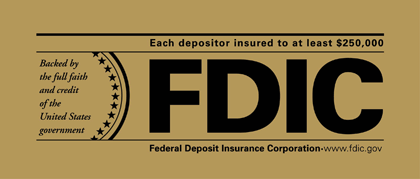The Federal Deposit Insurance Corporation (FDIC)
The Federal Deposit Insurance Corporation (FDIC) is an independent agency created by the Congress to maintain stability and public confidence in the nation's financial system by insuring deposits, examining and supervising financial institutions for safety and soundness and consumer protection, and managing receiverships. The FDIC promotes public confidence in the United States financial system by insuring depositors for at least $250,000 per insured bank. This is accomplished by identifying, monitoring, and addressing risks to the deposit insurance funds and by limiting the effect on the economy and the financial system when a bank or thrift institution fails.
An independent agency of the federal government, the FDIC was created in 1933 in response to the thousands of bank failures that occurred in the 1920s and early 1930s. Since the start of FDIC insurance on January 1, 1934, no depositor has lost a single cent of insured funds as a result of a failure. The FDIC receives no Congressional appropriations; it is funded by premiums that banks and thrift institutions pay for deposit insurance coverage and from earnings on investments in U.S. Treasury securities. The FDIC insures more than $7 trillion of deposits in U.S. banks and thrifts—deposits in virtually every bank and thrift in the country .

FDIC
The Federal Deposit Insurance Corporation (FDIC) is an independent agency created by the Congress to maintain stability and public confidence in the nation's financial system.
United States banks and credit unions are closely regulated and supervised to ensure that consumer money is safe. Banks and credit unions are required to comply with regulations.The Federal Deposit Insurance Corporation (FDIC) insures deposit accounts for banks and the National Credit Union Administration for credit unions.
In order to counter banks that engage in excessive risk taking, programs were developed for early intervention. The FDIC Improvement Act of 1991 limits regulators' discretion as to when to close troubled financial institutions (FIs). It requires that troubled FIs be recognized long before they become insolvent. For example, within 90 days of detection, critically undercapitalized FIs with tangible equity of less than 2% of assets must be placed in conservatorship or receivership. Public FIs can also utilize specific regulations to reallocate portfolios in ways that are deemed to be financially sound and socially beneficial. A good example is the prohibition against lending more than 10% of a bank's capital to any one borrower.